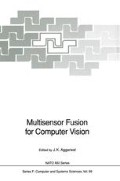Abstract
Three issues pertinent to a coordinated use of multiple sensors in a robot workcell are described. First we discuss how range maps obtained from multiple viewpoints — these viewpoints may correspond to range sensors located at different locations — can be fused to generate a single combined representation of an object. We then take up the subject of how to reason over all the viewpoints and all the available sensors so that the best sensor and the best viewpoint are selected for the maximum disambiguation of all the currently held hypotheses about object identities and their poses. Finally, we discuss how we may use multiple sensors for robotic assembly, each sensor helping execute a portion of the overall task.
Preview
Unable to display preview. Download preview PDF.
References
G. Castore, C. Crawford, “From Solid Model to Robot Vision,” Proc. of the IEEE Int’l Conf. on Robotics and Automation, 1984, pp. 90–92.
C. H. Chen and A. C. Kak, “A Robot Vision System for Recognizing 3-D Objects in Low-Order Polynomial Time,” IEEE Transactions on Systems Man and Cybernetics, November/December 1989, pp. 1535–1563.
R. L. Cromwell, “Low and Intermediate Level Processing of Range Maps,” Purdue University Technical Report TR-EE-87–41, 1987.
Z. Gigus and H. Malik “Computing the Aspect Graph for Line Drawings of Polyhedral Objects,” Proc. of the Computer Society Conf. on Computer Vision and Pattern Recognition, IEEE Computer Society Press, 1988, pp. 654–651.
S. N. Gottschlich and A. C. Kak, “A Dynamic Approach to High-Precision Parts Mat- ing,” IEEE Transactions on Systems Man and Cybernetics, vol. 19, no. 4, July/August 1989, pp. 797–810.
E. E. Hartquist, and H. A. Marisa, PADL-2 User’s Manual, Production Automation Pro- ject, University of Rochester, Rochester NY, 1985.
S. A. Hutchinson and A. C. Kak, “SPAR: A Planner that Satisfies Operational and Geometric Goals in Uncertain Environments,” AI MAGAZINE, Spring 1990, pp. 30–61.
S. A. Hutchinson and A. C. Kak, “Planning Sensing Strategies in a Robot Work Cell with Multi-Sensor Capabilities,” IEEE Trans. on Robotics and Automation, December 1989, pp. 765–783.
S. A. Hutchinson, R. L. Cromwell and A. C. Kak “Applying Uncertainty Reasoning to Model Based Object Recognition,” Proc. of the IEEE Conf. on Computer Vision and Pattern Recognition,1989.
A. C. Kak, K. M. Andress, C. Lopez-Abadia, M. S. Carroll and J. R. Lewis, “Hierarchical Evidence Accumulation in the PSEIKI System and Experiments in Model-Driven Mobile Robot Navigation,” Proc. of the Fifth Workshop on Uncertainty in Artificial Intelligence, Windsor Ontario, 1989, pp. 194–207.
J. J. Koenderink and A. J. Van Doorn, “The Internal Representation of Solid Shape with Respect to Vision,” Biological Cybernetics, Vol. 32, 1979, pp. 211–216.
G. Shafer, A Mathematical Theory of Evidence, Princeton University Press, 1976, Princeton.
J. H. Stewman, K. W. Bowyer, “Aspect Graphs for Convex Planar-Face Objects,” Proc. of the IEEE Workshop on Computer Vision, Dec. 1987.
S. Tanaka and A. C. Kak, “A Rule-Based Approach to Binocular Stereopsis,” in Analysis and Interpretation of Range Images R. C. Jain and A. K. Jain, editors, Springer-Verlag, NY, 1990.
Author information
Authors and Affiliations
Editor information
Editors and Affiliations
Rights and permissions
Copyright information
© 1993 Springer-Verlag Berlin Heidelberg
About this paper
Cite this paper
Kak, A.C., Hutchinson, S.A., Chen, C.H., Gottschlich, S.N., Smith, K.D. (1993). Coordinated Use of Multiple Sensors in a Robotic Workcell. In: Aggarwal, J.K. (eds) Multisensor Fusion for Computer Vision. NATO ASI Series, vol 99. Springer, Berlin, Heidelberg. https://doi.org/10.1007/978-3-662-02957-2_23
Download citation
DOI: https://doi.org/10.1007/978-3-662-02957-2_23
Publisher Name: Springer, Berlin, Heidelberg
Print ISBN: 978-3-642-08135-4
Online ISBN: 978-3-662-02957-2
eBook Packages: Springer Book Archive

